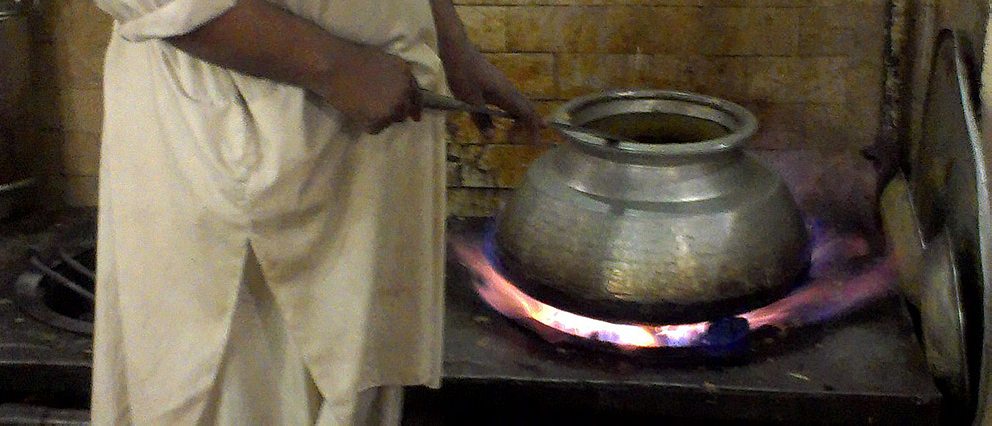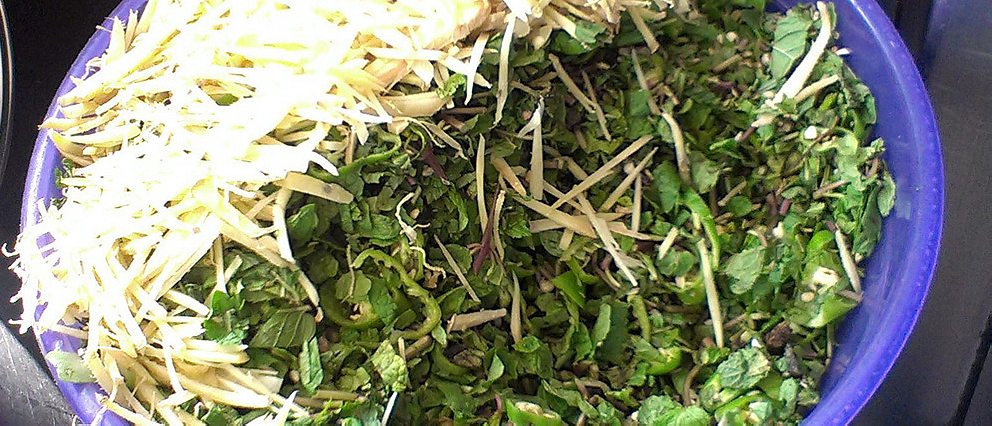After the preacher’s mic switches off and the congregation is exhausted from the exertion of their flagellation, the men and women of Karachi adjourn. It is time to eat haleem.
Karachi is a deeply cynical city, which gives it one advantage: it tends to quickly shrug off unrest and tragedy. Take the example of the recent riots over the Innocence of Muslims video. In one burst, protesters burned down six movie theaters and several banks. They attacked a KFC with equal vigor, looting Pepsi syrup, frozen chicken and plastic trays before trying to set the entire store on fire. The same day, my office ordered delivery from Espresso, the city’s most popular coffee chain, and someone hit the delivery guy in the head with a rock on his way over. He was fortunate he was wearing a helmet.
But the smell of burnt plastic hadn’t even cleared from the streets before the city opened for business again. Why mourn dead fast-food stores when on a normal day some eight to ten people are killed, whether in battles between warring gangs or in targeted assassinations or in random mob violence? Life in Pakistan’s largest city never pauses for them.
And yet, there is one time a year that Karachi does stop and shroud itself in black: the month of Muharram, the first month of the Islamic calendar, the month of mourning.
Muharram, which started on November 15 this year, is the most significant time on the Shiite calendar. It marks the martyrdom of the Prophet Muhammad’s grandson Imam Hussain ibn Ali in the Battle of Karbala in Iraq in 680 AD. Shiite groups hoist black flags over their neighborhoods, men and women clad themselves in black, and police officers brace for violence between the Shia and those extremists groups that consider their brand of Islam a heresy.
At Shiite congregations throughout the city, preachers retell the dramatic story of Karbala—a tale full of of starvation, bloody battles, child murder, and the ensuing captivity of Imam Hussain’s family in Damascus—as mourners chant ‘Ya Hussain’ and whip and cut themselves with their hands, knives and chains. By the end of the evening, bare-chested men are covered in blood, scars crisscrossing their backs, and women wander around with swollen eyes.
But after the preacher’s mic switches off and the congregation is exhausted from the exertion of their flagellation, the men and women adjourn. It is time to eat haleem.

Even outside of Muharram, haleem is one of the city’s most well-known dishes. Nearly every commercial district features a haleem restaurant with bubbling cauldrons of the spicy stew. In theory, it is a simple dish, a stew made of grains, lentils and beef. Imagine the consistency and color of a thick lentil soup, but with a slightly sour tang and a twinge of hot chilies. But for Pakistanis, there is a sense of grandeur associated with this humble stew. Shan Foods has gone so far as to market its pre-packaged mix of haleem spices as ‘Royal Haleem’.
But Muharram is haleem’s finest hour. For example, on the ninth night of Muharram, later this week, one of Karachi’s major streets will be taken over by stalls where vendors will give away haleem to Shiite mourners.
My formative haleem experiences had nothing to do with Muharram, but with discovering traditional Pakistani food. I was nine years old and had just moved to Pakistan after living in the United Arab Emirates, and my grandmother took my sister and me to a trade fair in Lahore, the capital of Pakistan’s Punjab province and the former seat of the Mughal Empire. After hours of wandering around, she wanted to eat and at the edge of the fairgrounds, she found a haleem vendor. She ordered a single serving. It arrived, sizzling on a metal plate, with a side of crisp, deep fried onions. She offered a taste in her typically brusque manner. If we didn’t want to eat it, she wasn’t going to ask again.
But I was addicted. I had never eaten anything that delicious. We scarfed down one plate, mopping it up with naan that dried up with the evening chill, and then ordered another. We went back at the next fair to look for the stall, but it never made another appearance. And even though we moved to Karachi the next year, when I go back to Lahore, my grandmother always has an order of haleem ready from some place she’s recently tried.

The stew is said to have originated in Persia, but the recipe was fine-tuned in Hyderabad, India and has been honed by Karachi’s restaurants for decades. Variations include hareesa, which features kebabs in the haleem base and is given a last minute fry-up with clarified butter. It is only sold in the winter in Pakistan’s Punjab province because it’s a heavier dish to consume.
But no one is able to explain why haleem has become an integral part of Muharram rituals. The common legend is that it was consumed during that battle of Karbala, as leftover grains and meat were stewed for the warriors. But a Shiite friend of mine raises a good point when I ask her about the haleem-in-war theory. “They didn’t have any food in the battle,” she says. “Why would they be eating haleem?”
Perhaps haleem fits with the holiday because it’s just the kind of simple, nutritious food that meshes with a celebration of piety. Others, like Shiite cleric Maulana Sadiq Raza Taqvi, tell me that eating haleem is “just a tradition” and has no historical background: “There is no set rule that haleem has to be served during Muharram.”
Syed Arshad Javed, the earnest manager of the Karachi Haleem restaurant in Burnes Road, where a stretch of restaurants sell some of the city’s best traditional dishes, subscribes to the Battle of Karbala origin story. It’s nearly two in the afternoon when I walk in to the restaurant and the smell of the simmering wheat and lentils from the kitchen makes me suddenly forget that I had a massive breakfast.
The restaurant opens up at 8 am and pulls the shutters down at 2:30 am, but in Muharram, the cooks start prep at 4 am. The cauldrons of haleem have been on the fire for four to five hours in the kitchen, where the walls are splattered with years of oil buildup. “I’m just warming this over,” says a weary cook, as he lifts up a foot-long ladle and stirs a cauldron. It is tiring just to watch, and his shirt sticks to his large frame with sweat and the steam from the pot.
“We start getting orders from the first day of Muharram,” says Javed. He’s cagey about details of the recipe. The most he’ll offer is that it’s made from “the best wheat, the best products, everything is fresh.”
At Mazedaar Haleem, around the corner from Karachi Haleem, two diners take in plates of haleem on a Sunday afternoon. Inam Khan, whose official designation is “owner’s nephew”, looks a little suspicious: “Are you here for the recipe?”
Mazedaar Haleem may be a competitor, but Inam Khan graciously admits that the two made “commercial haleem” popular in the city.
Khan says they start inventory of cauldrons and fixing the stoves a month before Muharram. “We sell around five to ten cauldrons a day.” Orders come in from Shiite neighborhoods, and though both restaurants work primarily on preorders, Mazedaar Haleem charges twenty rupees more (about 20 cents) for cauldrons that are booked on the spot. A cauldron contains 50 kilograms of haleem, enough to serve a hundred people. Javed is reluctant to tell me how many cauldrons they sell in a day, but insists, “It’s a lot.”

Even though homemakers scoff at ordering Pakistani takeout from restaurants—the favorite refrain is “this could be easily made at home”—haleem is an exception. Only the most dedicated of home cooks venture making it, since your arms go numb from stirring the pot for nearly half a day. One way to cut down the cooking time by a couple of hours is to use a packaged mix of spices, though puritans sniff at this, as they do at haleem made with chicken. Karachi Haleem serves both the beef and chicken versions. The latter, Javed says, is more popular in upscale neighborhoods. It also sells canned versions of haleem for expatriate Pakistanis to stuff into their suitcases and serve up in a moment of nostalgia. The restaurants sell other popular dishes like biryani (a spicy rice dish with chicken or beef) but haleem remains their bread and (clarified) butter.
Given the amount of oil and spices that go into it, haleem is a surprisingly light dish when compared to other Pakistani food. At the end of the meal, diners ask for a spoon to finish up the leftovers and if they’re feeling uninhibited, will clean up the plate with their fingers. Traditionally, it is eaten with fresh naan bread, topped off with a garnish of sliced ginger, chopped coriander, deep fried onions and green chilies, with a lemon wedge squeezed over the top and sprinkled with a mixed spice powder.
It is, says Javed, “even recommended by doctors.”
This gives me a bit of a flashback to being 16, delirious with typhoid, and cursing a relative who had brought over a container of haleem that I was not allowed to eat because I was on a strict diet of mashed potatoes. Whatever Javed may think about its medicinal properties, haleem isn’t really approved by the Pakistan Medical and Dental Council, or even the average home healer.
Haleem has had some cameos in Pakistani politics as well. A former minister told journalists how that the London-based chief of a rival political party had “cooked haleem” for him when he visited him in the UK. It has also made an appearance in several investigations by the Karachi police. “On the day of occurrence i.e. 03-01-2010 at about 0300-1300 hours he was present with his friends and cooking Haleem in a street next to the street where Akhlaq and his friends were cooking Haleem,” reads the confessional statement of an alleged criminal, as he described how a member of a political party was killed. Another investigative report mentions that among other charges, a suspect “looted Haleem Ghar (Haleem House)” with three accomplices.
The statement doesn’t mention whether they—like the rioters at KFC—stole the restaurant’s stock of haleem, but it’s a dish worth fighting for. After that first taste at the fair, I ate it every weekend for the next year, undaunted by the urban legend that a haleem stall owner in Lahore had been caught adding cotton balls to the cauldron. The story took on a life of its own, fuelled by reports in newspapers: the cotton was the ‘secret’ ingredient that gave haleem its texture. My mother tried to get me to stop, but I wouldn’t listen.
The same rumor dogged Karachi Haleem, who sued a news organization that made the allegation. The accusation, says Javed, doesn’t even make financial sense—“cotton is such an expensive item to add!”—and he whispers one possible culprit behind the accusations: “This was spread by fast-food restaurants to degrade traditional food.”
It’s hard to imagine the managers of KFC and Pizza Hut brainstorming about how to wean Karachiites off their haleem addiction, but Javed is content with his version of the story. I resist the urge to ask him if the KFC arson was hatched by haleem restaurant owners.
But the proof, I realize, is not in the lawsuit or the cotton, but in the bubbling cauldrons all over the city and the people queuing up at Karachi Haleem to place orders. As the call for “one chicken, six beef” goes out, the cooks keep up their stirring. The long month of Muharram lies ahead and there is no rest for those who are feeding the mourners.